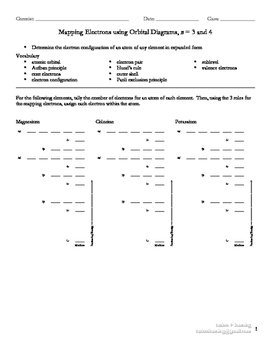

The Heisenberg Uncertainty Principle says - loosely - that you can't know with certainty both where an electron is and where it's going next. To plot a path for something you need to know exactly where the object is and be able to work out exactly where it's going to be an instant later. The impossibility of drawing orbits for electrons It is essential that you understand the difference between them. Orbits and orbitals sound similar, but they have quite different meanings. The truth is different, and electrons in fact inhabit regions of space known as orbitals. A simple view of the atom looks similar and you may have pictured the electrons as orbiting around the nucleus. When a planet moves around the sun, you can plot a definite path for it which is called an orbit. d orbitals are described only in terms of their energy, and f orbitals only get a passing mention. It explores s and p orbitals in some detail, including their shapes and energies. It can likewise be noticed that it isn't feasible for the 3f orbital to exist since that would require the estimation of 'n' and 'l' both to be equal to 3, which is absurd since the estimation of the azimuthal quantum number should consistently be lower than that of the key quantum number.This page explains what atomic orbitals are in a way that makes them understandable for introductory courses such as UK A level and its equivalents. The names of these atomic orbitals would then be 3s for n=3, l=0 3p for n=3, l=1 and 3d for n=3 and l=2. For example, if the estimation of 'n' is equal to 3, the potential estimations of 'l', which range from zero to (3-1), are 0, 1, and 2. For some random estimation of 'n', the estimation of 'l' can range from zero to (n-1). Note that the estimation of the azimuthal quantum number is subject to the estimation of the important quantum number. When naming a particular atomic orbital, the estimation of the essential quantum number must be added as a prefix to the sequential description of the azimuthal quantum number. Subsequently, when l=6, the name of the atomic orbital will be 'I' and when l=7, the name of the atomic orbital will be 'k'. It very well may be noticed that the next atomic orbitals can be named one after another in order, precluding the letter 'j' (which is done in light of the fact that specific dialects don't recognize the letters 'j' and 'I').

The h orbital, in which the estimation of the azimuthal quantum number equals to 5. The g orbital, in which the estimation of the azimuthal quantum number equals to 4. The f orbital, in which the estimation of the azimuthal quantum number equals to 3. The d orbital, in which the estimation of the azimuthal quantum number equals to 2.

The p orbital, in which the estimation of the azimuthal quantum number equals to 1. The s orbital, in which the estimation of the azimuthal quantum number equals to 0. The straightforward names of the atomic orbitals and the comparing estimation of the azimuthal quantum number are given below.

The name of an atomic orbital is normally expressed as far as a combination of the primary quantum number (n) and the azimuthal quantum number (l). In totally involved atomic orbitals, for example, the atomic orbitals containing two electrons, every one of the electrons has an equal and opposite turn when contrasted with the other.ĭifferent Atomic Orbitals and the Relationship Between Different Quantum Numbers which Describe Them The magnetic quantum number (noted by the symbol ' m l ')īesides, it very well may be noticed that each atomic orbital can hold a maximum of two electrons. The azimuthal quantum number, otherwise called the orbital precise energy quantum number (signified by the symbol 'l') The principal quantum number (noted by the symbol 'n') Note that the qualities of each atomic orbital are reliant upon the estimations of the following quantum numbers: The presence of an electron in such a region is anticipated by the mathematical form of the atomic orbital. Note that the term 'atomic orbital' can likewise be utilized to allude to the physical space or physical region around an atom's nucleus in which the likelihood of a particular electron being available is maximum. In the fields of quantum mechanics and atomic theory, these mathematical functions are frequently utilized to decide the likelihood of finding an electron (having a place with an atom) in a particular region around the nucleus of the atom. Atomic orbitals are mathematical functions that give knowledge into the wave nature of electrons (or sets of electrons) that exist around the cores of atoms.


 0 kommentar(er)
0 kommentar(er)
